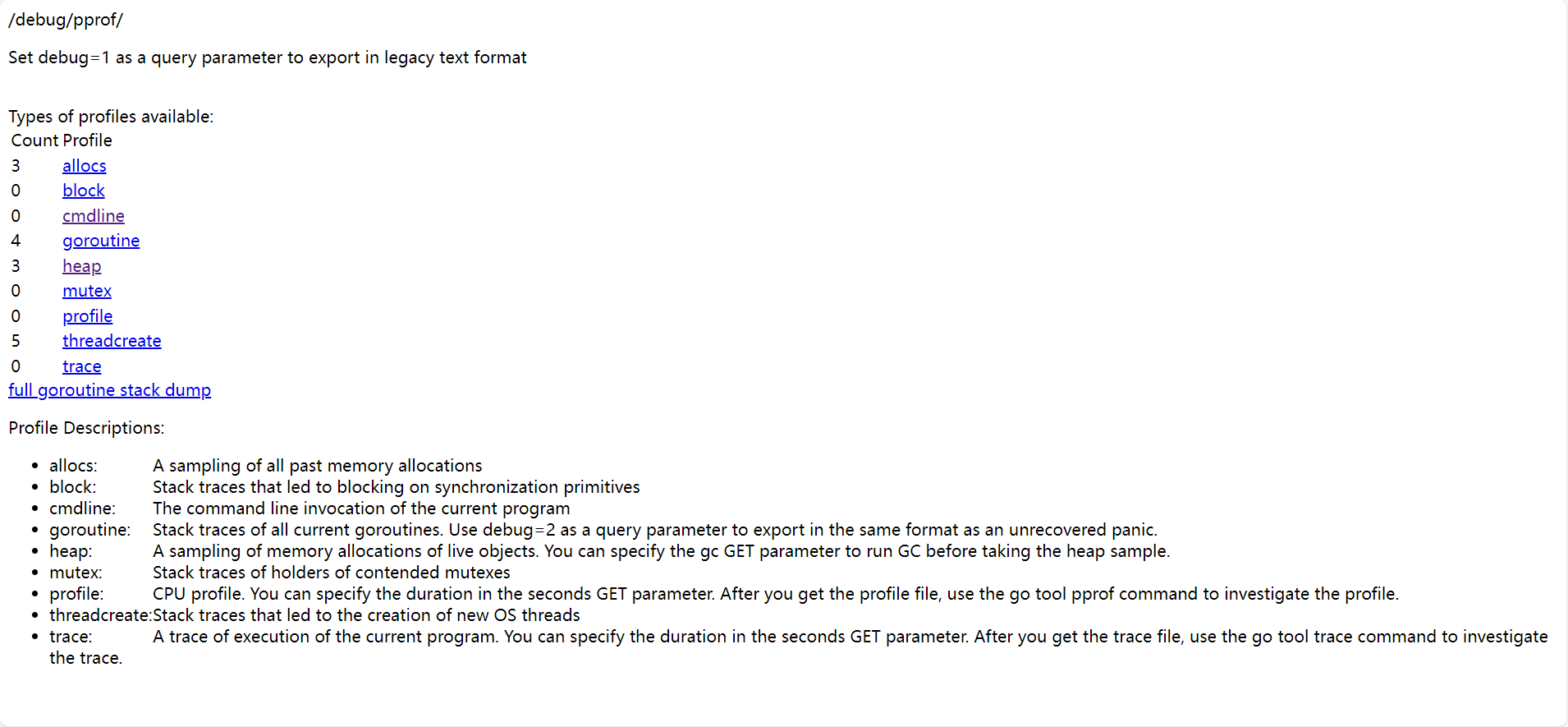-
golang入门笔记——pprof性能分析
简介
golang性能分析工具pprof的8个指标
1.性能分析的5个方面:CPU、内存、I/O、goroutine(协程使用情况和泄漏检查)、死锁检测以及数据竟态分析
runtime.SetMutexProfileFraction(1) //开启对锁调用的跟踪 mutex runtime.SetBlockProfileRate(1) //开启对阻塞操作的跟踪- 1
- 2
2.两种程序性能指标采集
runtime/pprof:采集工具型应用运行数据进行分析 net/http/pprof:采集服务型应用运行时数据进行分析- 1
- 2
pprof开启后,每隔一段时间(10ms)就会收集下当前的堆栈信息,获取各个函数占用的CPU以及内存资源;最后通过对这些采样数据进行分析,形成一个性能分析报告。
3.交互式终端性能分析
不管是工具型应用还是服务型应用,我们使用相应的pprof库获取数据之后,下一步的都要对这些数据进行分析,我们可以使用go tool pprof命令行工具。
go tool pprof [binary] [source] #binary是应用的二进制文件,用来解析各种符号 #source标识profile数据的来源,可以是本地的文件,也可以是http地址- 1
- 2
- 3
4.web网页性能分析
如果你的应用程序是一直运行的,比如 web 应用,那么可以使用net/http/pprof库,它能够在提供 HTTP 服务进行分 析。 如果使用了默认的http.DefaultServeMux(通常是代码直接使用 http.ListenAndServe(“0.0.0.0:8000”, nil)),只需要 在你的web server端代码中按如下方式导入net/http/pprof- 1
- 2
- 3
- 4
如果你使用自定义的 Mux,则需要手动注册一些路由规则:
r.HandleFunc("/debug/pprof/", pprof.Index) r.HandleFunc("/debug/pprof/cmdline", pprof.Cmdline) r.HandleFunc("/debug/pprof/profile", pprof.Profile) r.HandleFunc("/debug/pprof/symbol", pprof.Symbol) r.HandleFunc("/debug/pprof/trace", pprof.Trace)- 1
- 2
- 3
- 4
- 5
如果你使用的是gin框架,那么推荐使用github.com/gin-contrib/pprof,在代码中通过以下命令注册pprof相关路由。
pprof.Register(router)- 1
访问地址:http://host:port/debug/pprof会出现性能分析的网页
这个路径下还有几个子页面:
/debug/pprof/profile:访问这个链接会自动进行 CPU profiling,持续 30s,并生成一个文件供下载 /debug/pprof/heap: Memory Profiling 的路径,访问这个链接会得到一个内存 Profiling 结果的文件 /debug/pprof/block:block Profiling 的路径 /debug/pprof/goroutines:运行的 goroutines 列表,以及调用关系- 1
- 2
- 3
- 4
runtime/pprof的使用
代码:
package main import ( "flag" "fmt" "os" "runtime/pprof" "time" ) func logicCode() { var c chan int for { select { case v := <-c: fmt.Printf("recv from chan, value:%v\n", v) default: } } } func main() { var isCPUPprof bool var isMemPprof bool flag.BoolVar(&isCPUPprof, "cpu", false, "turn cpu pprof on") flag.BoolVar(&isMemPprof, "mem", false, "turn mem pprof on") flag.Parse() if isCPUPprof { file, err := os.Create("./cpu.pprof") if err != nil { fmt.Println("create cpu pprof failed,err:", err) return } pprof.StartCPUProfile(file) defer file.Close() defer pprof.StopCPUProfile() } for i := 0; i < 8; i++ { go logicCode() } time.Sleep(20 * time.Second) if isMemPprof { file, err := os.Create("./mem.pprof") if err != nil { fmt.Println("create mem pprof failed,err:", err) return } pprof.WriteHeapProfile(file) file.Close() } }- 1
- 2
- 3
- 4
- 5
- 6
- 7
- 8
- 9
- 10
- 11
- 12
- 13
- 14
- 15
- 16
- 17
- 18
- 19
- 20
- 21
- 22
- 23
- 24
- 25
- 26
- 27
- 28
- 29
- 30
- 31
- 32
- 33
- 34
- 35
- 36
- 37
- 38
- 39
- 40
- 41
- 42
- 43
- 44
- 45
- 46
- 47
- 48
- 49
- 50
- 51
- 52
- 53
- 54
- 55
命令行交互
使用go工具链里的pprof来进行分析
go tool pprof cpu.pprof #go tool pprof http://127.0.0.1:8000/debug/pprof/profile- 1
- 2

topN来获取占用CPU前几位的函数:
top3 #获取占用CPU前3位的函数- 1

flat:当前函数占用CPU的耗时
flat%:当前函数占用CPU耗时占总CPU耗时的百分比
sum%:函数占用CPU的耗时累计百分比
cum:当前函数加上当前函数调用函数占用CPU的总耗时
cum %:当前函数加上当前函数调用函数占用CPU总耗时百分比
最后一列:函数的名称list 函数名,查看具体的函数分析
list logicCode- 1

可以看出函数的所有耗时都在 case v:=<-c这条语句的执行中。网络服务性能分析
package main import ( "fmt" "net/http" _ "net/http/pprof" "strings" ) func main() { http.HandleFunc("/hello", func(w http.ResponseWriter, r *http.Request) { r.ParseForm() fmt.Println(r.Form) fmt.Println("path:", r.URL.Path) fmt.Println("scheme:", r.URL.Scheme) for k, v := range r.Form { fmt.Println("key:", k) fmt.Println("val:", strings.Join(v, "")) } w.Write([]byte("hello world")) }) http.ListenAndServe("127.0.0.1:8080", nil) }- 1
- 2
- 3
- 4
- 5
- 6
- 7
- 8
- 9
- 10
- 11
- 12
- 13
- 14
- 15
- 16
- 17
- 18
- 19
- 20
- 21
- 22
- 23
第一种方式:
#分析5s内对应服务的性能 go tool pprof -seconds=5 http://127.0.0.1:8080/debug/pprof/profile #go tool pprof -seconds=5 http://127.0.0.1:8080/debug/pprof/heap- 1
- 2
- 3
第二种方式:
下载原始数据文件到XXX-X.out目录,对于一些需要累计到一些时间才能采集的指标,我们可以使用?seconds=X来设置
curl -o XXX-X.out http://127.0.0.1:8080/debug/pprof/XXX?seconds=X#获取10s内内存的使用情况 curl -o profile.out http://127.0.0.1:8080/debug/pprof/heap?seconds=10 go tool pprof profile.out- 1
- 2
- 3

对gin服务进行性能分析
package main import ( "fmt" "github.com/gin-contrib/pprof" "github.com/gin-gonic/gin" ) func main() { r := gin.Default() r.GET("/hello", func(c *gin.Context) { var ch chan int select { case v := <-ch: fmt.Println(v) default: } }) pprof.Register(r) r.Run() }- 1
- 2
- 3
- 4
- 5
- 6
- 7
- 8
- 9
- 10
- 11
- 12
- 13
- 14
- 15
- 16
- 17
- 18
- 19
- 20
- 21
- 22
- 23
访问网址:http://localhost:8080/debug/pprof

3 allocs:表示过去进行过3次内存分配
0 block:表示0个阻塞
0 cmdline:执行的命令行
4 goroutine:创建的goroutine数量
3 heap:3个活动中的对象内存分配情况
0 mutex:当前锁竞争的数量
0 profile:cpu使用情况进行采用,默认采样30s,后面加参数seconds=60来指定时间
5 threadcreate:线程的创建数
0 trace:整个程序的运行过程的跟踪pprof与性能测试结合
go test命令有两个参数和pprof相关,它们分别指定生成的CPU和Memory profiling保存的文件
-cpuprofile: cpu profiling数据要保存的文件地址 -memprofile:memory profiling数据要保存的文件地址- 1
- 2
go test -bench . -cpuprofile=cpu.prof go test -bench . -memprofile=./mem.prof go test -bench . -blockprofile=./block.prof- 1
- 2
- 3
- 4
- 5
- 6
压测工具go-wrk
go-wrk的包的下载
go get github.com/adeven/go-wrk- 1
go-wrk的使用格式
go-wrk [flags] url
常用参数:
-H="User-Agent: go-wrk 0.1 bechmark\nContent-Type: text/html;": 由'\n'分隔的请求头 -c=100: 使用的最大连接数 -k=true: 是否禁用keep-alives -i=false: if TLS security checks are disabled -m="GET": HTTP请求方法 -n=1000: 请求总数 -t=1: 使用的线程数 -b="" HTTP请求体 -s="" 如果指定,它将计算响应中包含搜索到的字符串s的频率- 1
- 2
- 3
- 4
- 5
- 6
- 7
- 8
- 9
go-wrk -t=8 -c=100 -n=10000 "http://127.0.0.1:8080/api/v1/posts?size=10"- 1
输出结果
==========================BENCHMARK========================== URL: http://127.0.0.1:8080/api/v1/posts?size=10 Used Connections: 100 Used Threads: 8 Total number of calls: 10000 ===========================TIMINGS=========================== Total time passed: 2.74s Avg time per request: 27.11ms Requests per second: 3644.53 Median time per request: 26.88ms 99th percentile time: 39.16ms Slowest time for request: 45.00ms =============================DATA============================= Total response body sizes: 340000 Avg response body per request: 34.00 Byte Transfer rate per second: 123914.11 Byte/s (0.12 MByte/s) ==========================RESPONSES========================== 20X Responses: 10000 (100.00%) 30X Responses: 0 (0.00%) 40X Responses: 0 (0.00%) 50X Responses: 0 (0.00%) Errors: 0 (0.00%)- 1
- 2
- 3
- 4
- 5
- 6
- 7
- 8
- 9
- 10
- 11
- 12
- 13
- 14
- 15
- 16
- 17
- 18
- 19
- 20
- 21
- 22
- 23
- 24
- 25
- 26
-
相关阅读:
农产品行业的春天来了,乘风破浪颠覆传统营销,实现一户带一户,共同致富,这套农产品生态方案可收藏借鉴
CAPL中的CAN消息:声明、发送和接收
【毕业设计】基于javaEE+SSH+SQL Server的学生信息管理系统设计与实现(毕业论文+程序源码)——学生信息管理系统
java-net-php-python-63java长途汽车站售票系统计算机毕业设计程序
解决phpstudy无法启动MySQL服务
Vue中的懒加载是什么,如何实现懒加载?
[附源码]Python计算机毕业设计Django房产中介管理系统
弘辽科技:网店提升销量先提升流量吗?怎么提升流量?
MySQL:JDBC编程
完整数字华容道02:软件结构设计
- 原文地址:https://blog.csdn.net/qq_43716830/article/details/132968951
